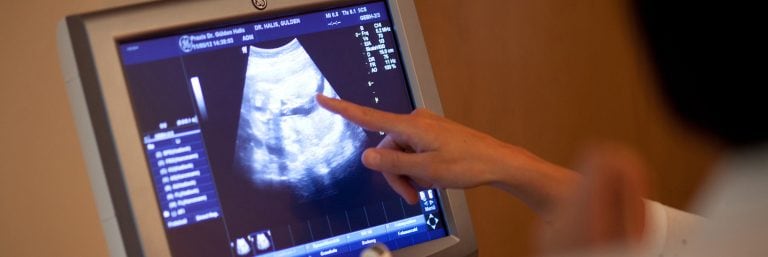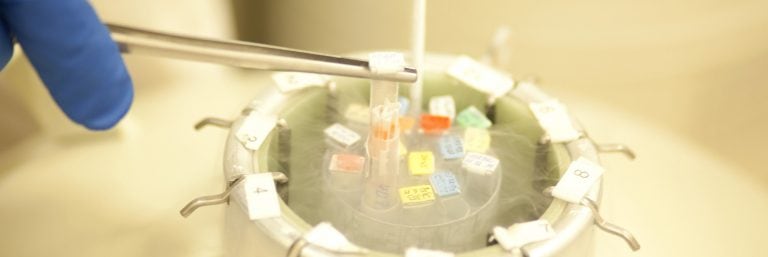Causes of infertility
Causes for sterility can occur in both men and women.
Male causes of infertility
Limitations of testicular function
The limitation of semen quality can affect all three main factors (concentration, motility, percentage of normal body shape) of sperm quality. Infection-related testicular damage (also mumps), testicular varicose veins (varicocele) or occupational pressure or temperature influences, but also radiation exposure is associated with loss of sperm quality. An undescended testicle treated too late often also leads to a reduction in sperm quality.
Malposition or occlusion of the seminal ducts
Certain genetic disorders or even inflammations can lead to the fact that the discharging seminal ducts are either not created at all or that they stick together. Here, too, the possibly highly feverish mumps infection plays an important role.
Hormone Disorders
Relatively seldom hormone disorders are often the reason for limited sperm production. A not uncommon example of a self-induced hormone shift is the use of anabolic steroids.
Immunological factors
For example, due to long sperm retention, infection-related or after vasectomy (surgical closure of the sperm duct), antibodies form against the patient’s own sperm, which reduces their ability to fertilize.
Condition after vasectomy
A consequence of surgical closure of the spermatic duct as a method of male contraception is that the sperm is unable to appear in the ejaculate.
Neurological and psychological factors
In case of paraplegia or after surgery for tumors in the genital area, erection and ejaculation disorders may occur.
In so-called retrograde ejaculation, ejaculation does occur, but in the “wrong” direction, namely into the bladder.
Mental disorders can cause libido disorder (sexual desire disorder) and associated ejaculation disorder or an erectile dysfunction leading to an incapability to achieve pregnancy.
Chromosomal disorders
Sperm maturation in the testicles can be disturbed by certain chromosomal disorders, so that even during a testicular biopsy (removal of testicular tissue) mature sperm capable of fertilization cannot be found.
Malformations
There are developmental disorders of the penis in which the urethra does not open at the glans penis but in the area of the penis shaft, so that during ejaculation the sperm cells cannot easily reach the area of the cervix.
Female causes of infertility
Endometriosis and sterility
Endometriosis is one of the most common causes of unwanted childlessness in young women. In more than 50% of women with fertility problems, endometriosis is found in the laparoscopy performed for clarification.
How endometriosis develops is not yet fully understood.
Bonding, adhesions and fallopian tube obstructions can lead to “mechanical” obstacles. Endometriosis cysts in the ovaries can hinder the maturation of the egg cells. The endometriosis lesions cause a persistent inflammatory reaction in the abdomen. This can interfere with the maturation of the egg cells just as much as the quality of the sperm or can lead to the implantation of a fertilized egg being hindered.
IVF treatment does not always have to be performed immediately. Your doctor will advise you in detail according to the stage of your disease. Spontaneous pregnancies are also possible with endometriosis. If endometriosis causes severe pain during sexual intercourse, many couples shy away from sexual intercourse or no longer sleep together at all.
The reasons for female sterility can be divided as follows:
Hormonal causes (frequency approx. 30 % purely among female causes of sterility)
The proper functioning of the sensitive hormonal structure between the diencephalon, pituitary gland and ovaries (the so-called “hypothalamic-pituitary-ovarian axis”) is important for a smooth ovarian cycle. Here, under optimal conditions, a mature egg is formed during the fertile phase of a woman (between 15 and 40 years of age) and increasingly irregularly beyond that (up to 45 years of age) in each cycle.
The hypothalamus (part of the diencephalon), as the superior part of the brain, controls the regular release of gonadotropins (sex hormones) such as FSH (follicle-stimulating hormone), which stimulates follicle maturation, and LH (luteinizing hormone), which ultimately triggers ovulation.
The perfect interaction of these hormones is influenced by other hormones, such as prolactin, thyroid hormones, male hormones and insulin. The smallest deviations within this system can disturb the correct development of the follicles.
External factors that change the hormonal structure, such as professional, competitive sports and major psychological stress, can also cause sterility.
Hormonal disturbances can not only be a hindrance in achieving pregnancy, they can also have a negative effect on the child’s development or lead to a miscarriage.
Tubar sterility (frequency approx. 30 %)
As a result of inflammation of the fallopian tube mucous membrane, the transport of the egg from the ovary to the uterus can be disrupted. In extreme, however not so rare cases, one or both fallopian tubes may be completely blocked. This condition is often caused by bacteria such as Chlamydia.
Inflammatory processes (ovarian inflammation or appendicitis) often lead to local inflammatory reactions, which result in the formation of adhesions. As a result, the fallopian tubes may be restricted in their mobility, which hinders the catching function of the fallopian tube ends (fimbriae). At ovulation, the egg must be captured by the end of the fallopian tube and then transported further down the fallopian tube, where fertilization finally takes place. If the passage of the egg or the early embryo is severely impaired, premature implantation in the fallopian tube may occur, resulting in a life-threatening condition (ectopic pregnancy). Especially endometriosis as a non-bacterial source of inflammation, which is discussed in more detail in the respective section, can have these and other consequences.
Uterine sterility (frequency approx. 5 %)
There are various malformations of the uterus, such as the septal uterus, subseptal uterus and arcuate uterus, which can interfere with the implantation or development of an embryo.
Depending on their size and growth site (uterine cavity, uterine wall, uterine surface) Myomas (benign muscle growths) can also restrict fertility. So-called endometrial polyps (local overproduction of mucous membrane) or adhesions after inflammation or as a result of scrapings (also abortions) limit fertility.
A further problem is the poorly developing endometrium without a recognizable cause.
Cervical sterility (frequency approx. 5 %)
Cervical tears or inflammation are detrimental to the patency of the sperm. In particular, the property of the cervical mucus at the time of a woman’s ability to fertilize can be altered by a lack of estrogens in such a way that the sperm are prevented from further ascending from the vagina (vagina) towards the uterus.
Vaginal sterility (frequency approx. 5 %)
Malformations or stenoses can prevent sexual intercourse. Inflammatory processes can promote miscarriage or premature birth.
Immunological sterility (frequency approx. 5 %)
There is still much speculation about the importance of sperm antibodies and the possible “rejection reaction” between sperm and egg. The therapies resulting from suspected immunological causes are doubtful and controversial in their effectiveness.
Blood coagulation disorders (frequency approx. 5 %)
Various congenital disorders of the so-called “cascade of blood coagulation” can, without having any discernible influence on daily life, have a negative effect on the probability of becoming or remaining pregnant. These disorders, which are grouped together under “thrombophilia”, can sometimes be successfully treated with anticoagulants.
Chromosomal disorders (frequency approx. 5 %)
Congenital disorders, such as numerical chromosomal aberration (deviation from the normal number of chromosomes) in all cells or in a part of the cells of the body (mosaic formation) can also prevent pregnancy. On the other hand, they can increase the probability of miscarriages.






